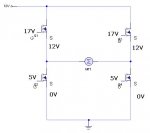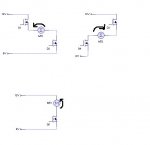Hi i fairly new to picaxe and built a board to run a 12v dc motor using a 12vdc 2.5A power supplie i scrounged from some where and i then built a board using 4 IRL540s to control direction but it didn't work
does a PICAXE output pin have enough grunt to run to IRL540s ?
thanks in advance
Atarian
does a PICAXE output pin have enough grunt to run to IRL540s ?
thanks in advance
Atarian


